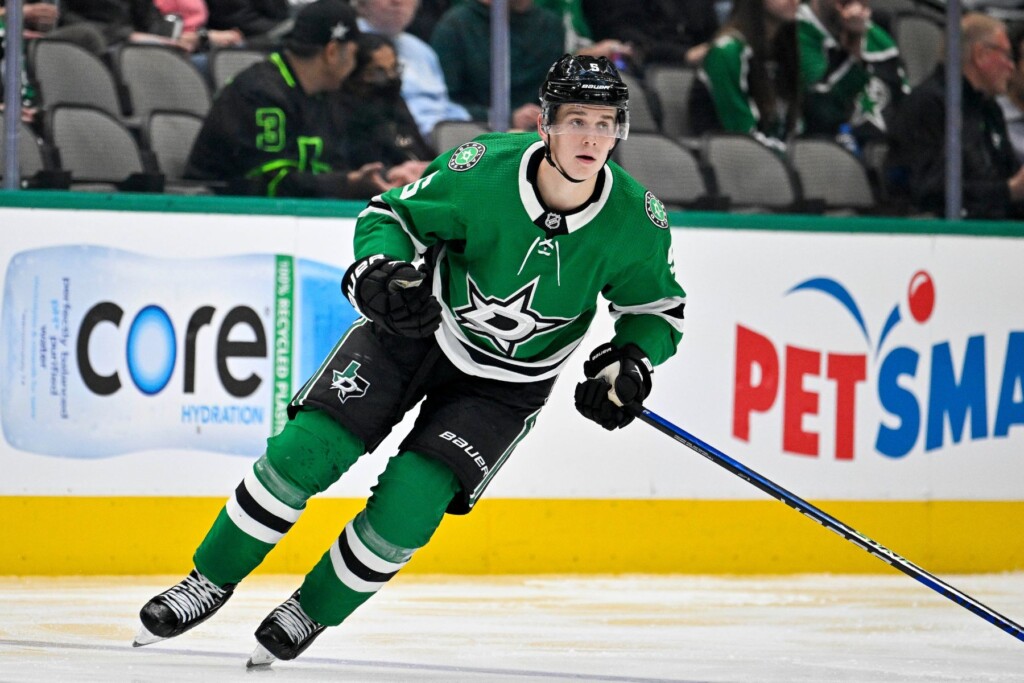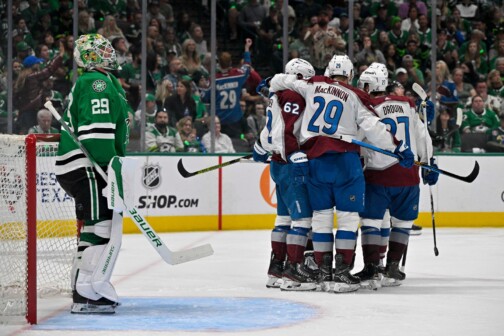The Stars have many ways to better their blueline. They can aim high and transform their defense overnight at the cost of making literally any other move by going after San Jose’s Erik Karlsson. They can aim lower and improve their defense overnight at the cost of jamming their left side by going after Calgary’s Noah Hanifan. There are low-key effective trades, like the Flames’ Chris Tanev, and there are low-key disastrous trades, like the Blues’ Colton Parayko. Any one of those deals would likely cost a first-round pick in the impossibly deep 2023 NHL Draft. That’s part of why we probably won’t see any of those names in Dallas next season, because Jim Nill already moved Dallas’ first-round pick for a different defenseman.
The Nils Lundkvist trade had plenty of Stars fans excited. I was pretty fired up myself. Here was a move very outside the typical Nill playbook, and it happened to fetch one of the NHL’s best prospects in return. (Lundkvist ranked 38th on EPRinkside’s top 100 board in 2022.) But nobody remembers all that right now after a disappointing first season in Dallas, as Lundkvist’s ice time fluctuated all season long en route to not making the playoff roster.
In Dallas, we call that getting “Honka-ed,” after the former first-round defenseman Julius Honka, whose own Stars career petered out following an up-and-down first full season in Dallas. Lundkvist played 60 games this year to Honka’s 42 in 2017-18, a difference that feels insignificant considering Honka at least played NHL games into April, while Lundkvist didn’t play at all after March. Like Honka, Lundkvist ended up getting passed by Joel Hanley on the depth chart, too.
But while Honka was a modest reach on draft day, Lundkvist was a longstanding target, a player intended to replace some of what John Klingberg brought to a playoff team. He couldn’t, and the trickle-down effect impacted the entire blueline, from Ryan Suter getting more minutes than he should to Miro Heiskanen once again being asked to play on his weaker side to precious little offense coming from the bottom two pairs prior to Thomas Harley cementing himself as a lineup fixture come playoff time. That’s a big difference with even bigger consequences.
Of course, the Stars weren’t crazy to identify weaknesses in Lundkvist’s game as the season wore on. When the 22-year-old was on the ice, Dallas was outscored 38 to 36. His expected goals against of 2.59 per 60 minutes of even-strength play ranked last among all Dallas blueliners. His habit of dumping the puck out, which I once took as a hopeful sign of maturity, ended up looking like an inherent limitation. On a team hampered by a lack of breakout passing, Lundkvist was no exception to the rule.
His season was finished on March 18. On that night, Calgary’s first goal was scored after intercepting his dumpout. The Swedish defender played just two minutes that night and went on to play only two more games for the rest of the season.
There’s no good statistical defense for Lundkvist, but that doesn’t mean any defense of him is without logic. This is where Dallas’ endgame gets confusing. Lundkvist was brought in to add offense, so why didn’t he play on the second power-play unit? What could have been a clean way to help Lundkvist further leverage his strengths—rather than ask him to fix his weaknesses—instead became a participation award for Suter’s long career despite the fact that the 38-year-old only scored one more point in 50 more minutes on the man advantage. His 1.81 points per hour on the power play ranked 255th out of 268 players with at least 100 man-advantage minutes this past season. Growing pains or no, Lundkvist at least provided an element of danger that the unit sorely needed.
For that matter, whatever Lundkvist’s weaknesses, at least they were to be expected. In terms of strengths, he was brought in to improve shot quality from the back end and capitalize on offensive chances. Overall, that’s exactly what he did.
The potential is still there. Lundkvist is in his early 20s, and his first goal in a Stars uniform was one of the most spectacular goals of the year. He had shifts that downright mesmerized. There is plenty to hope on, and plenty of opportunity considering Dallas’ dearth of right-handed defensemen.
This is where the Stars find themselves at a crossroads. It’s the same one all teams face when they decide playing young players is at odds with winning games. Dallas fans saw it with Ken Hitchcock in 2018. Montreal fans saw it with Dominique Ducharme in 2022. The list goes on, and it always keeps growing. Winning teams don’t have time to babysit.
Or so it’s said. The problem with this logic is that it treats wins and losses like a zero-sum game. If that were the case, then why would Lundkvist’s turnover versus Calgary hold more weight than Suter’s turnover versus Vegas? We know why: veterans have a history of being trustworthy while prospects do not. But that means there are off-ice reasons to tolerate mistakes, in which case: what makes the off-ice reason for respecting a veteran’s past superior to respecting a prospect’s future?
This isn’t an attack on Pete DeBoer’s evaluation of Lundkvist so much as a challenge to teams’ expectations of their prospects. The Stars paid for a slightly used sports car and got a slightly used sports car; they’re shocked it can’t go four wheeling? Now they must contend with giving up a first-rounder that could have been used elsewhere (on the trade market or on a player in a very deep 2023 draft class) while learning nothing new about their blueline. That makes the consequence of last year’s trade far wider-reaching.
Humor me for a moment, and imagine Lundkvist played all 82 games and suited up for all 19 playoff contests. Had that happened, we’d be talking about whether he was good enough and nothing else. Had he proven himself capable, perhaps we’re not talking about transforming the blueline, and the offseason conversation shifts instead toward bringing back Max Domi and Evgenii Dadonov, along with maybe using some hypothetical Suter buyout cash on another quality depth forward. (This UFA class offers many.) On the other hand, maybe we find out Lundkvist was a gamble that Nill lost. Not ideal, of course, but either way Dallas ends up with more information, more certainty, and a better understanding of the future.
Now the Stars are stuck in between: not knowing whether Lundkvist is part of their core or a sunk cost. His lack of opportunities means there’s no way to learn more about how Lundkvist might have dealt with that added responsibility. How is he supposed to gain critical experience if he’s denied power play time, overtime shifts, and playoff games? Maturation is a cumulative process, and Dallas needs to let the Swede solve the small problem of playing through his mistakes before asking him to solve larger ones.
Anything less than the necessary progress to gain Pete DeBoer’s trust next season will be disastrous. At best, all the Stars would have to show for a valuable pick is firmly ruling Lundkvist out as a possible solution to an obvious problem. At worst, the Lundkvist trade represents one more roadblock to improving a team squarely in its contention window.
It is imperative Dallas gets this right. Lundkvist made mistakes, and he’ll make them again. But if Dallas’ final game of the season made anything clear, it’s that even veterans can make disastrous mistakes, too. Those mistakes shouldn’t define the players. They should remind them that they can do better.
Lundkvist deserves that opportunity.
Author








